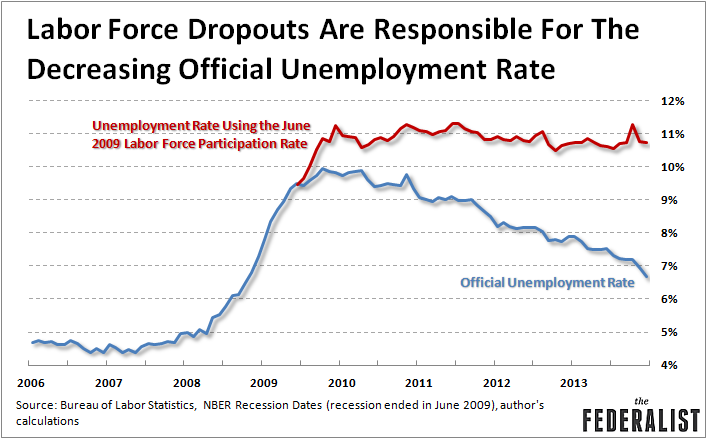 |
| "Ignore these numbers. They were all made by racists." |
Well, many people knew that the dropping unemployment rate was due to people giving up looking for hard to come by jobs and start collecting from the government. However, the actual numbers are pretty shocking.
From The Federalist article by Sean Davis (h/t Ace of Spades):
Yes, the unemployment rate has fallen significantly from its high of 10 percent in October of 2009. But it turns out the unemployment rate has been falling for a pretty depressing reason: people dropping out of the labor force. Last month, 347,000 workers dropped out, effectively sending the message that it wasn’t even worth looking for work anymore.
Here’s what the unemployment rate would look like if the labor force participation rate — basically the number of people in the economy working or looking for work — had remained constant since June of 2009:
[...]
To understand how the labor force numbers affect the unemployment rate, it helps to understand how the unemployment rate is calculated. First, BLS determines who is a member of the civilian non-institutional population: people who are 16 years of age or older who are not inhabitants of institutions (prisons, mental institutions, etc.) and not active duty members of the U.S. military. Next, BLS determines what percentage of those individuals are members of the labor force: that roughly consists of people who are either working or are looking for work. Then, BLS determines how many individuals within the labor force are employed. Subtracting the number of employed persons from the labor force gives you the number of unemployed, and dividing the number of unemployed by the total labor force gives you the unemployment rate.
If you hold total employment constant and increase the size of the labor force, the number of unemployed persons will increase, as will the unemployment rate. A shrinking labor force, however, can completely mask a serious job shortage by excluding those who stop looking for work altogether from the calculation of unemployed persons.
In June of 2009, the labor force participation rate was 65.7 percent (by way of comparison, the average over the last decade is 65.1 percent, while the peak was 66.5 percent in June of 2003). Since the end of the recession, that number has nose-dived. At the end of last month, it hit 62.8 percent — on par with what the U.S. experienced in the late 1970′s (although at the time, the number was on the upswing).
What does this all mean? Rather than being the sign of a vibrant economy, the falling unemployment rate is actually an arithmetic artifact of the BLS head-counting process. If the labor force participation rate had held steady since 2009, the number of people in the labor force today would total nearly 162 million people. Instead, BLS reports the official number to be just shy of 155 million.
And thanks to how BLS calculates and reports the official unemployment rate, those 7 million people are not included among the ranks of the unemployed. Add them back in and you have an unemployment rate that averages a very stubborn 10.8 percent since the end of the recession.
Some recovery, huh?
Obama's a liar and his policies are pathetic, ineffective, and harmful to the economy. We're not recovering. The government is using barely effective measures to ease the pain and not treating the disease-- prescribing morphine while a patient is having a heart attack. But even that analogy is far too kind, as morphine wouldn't actually cause much further damage to the patient, while Obama's policies are really hurting the American economy.
We're in the most incompetent of hands.



No comments:
Post a Comment